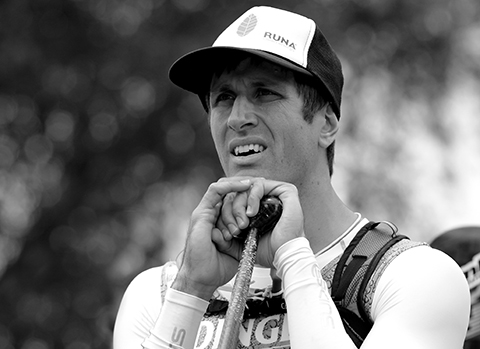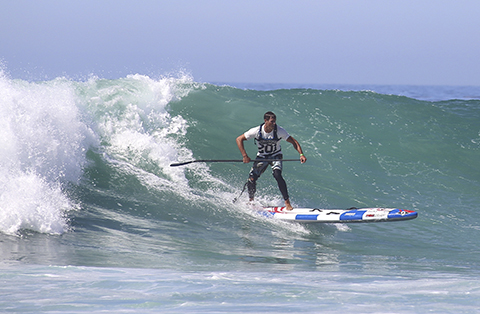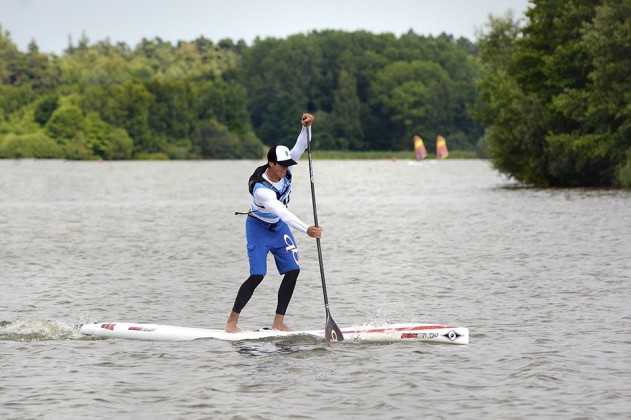CHASE KOSTERLITZ CREATE YOUR OWN RACE
You saw the ISA World’s live stream, then the Euro Cup came to town, and now you’ve got this inexplicable fire burning within you to get out and challenge your fellow man. However, the nearest race is three counties away and kids, work, DIY etc…means that unless a race pops up on your doorstep, that fire is going to fizzle out. Well guess what, there WILL be a race on your local beach, you’re going to organise it and Chase Kosterlitz, president of the Stand Up Paddle Athletes Association, author of SUP Training The Smart Way and one of the most dominant SUP racers on the planet with advice for first time organisers and racers alike, is going to explain how…
With Chase Kosterlitz // Photos L Navarez

Advice for the Race Organiser
Setting out your course: distance, shape, wind n’ sea
5km seems to be the standard beginner level SUP course. It is best to work in distance as this usually correlates directly with duration. It is important to take into account water conditions. Calm water conditions with as little wind as possible is always preferable. Keep it simple, safe and entertaining for the competitors. Use your surroundings to set the course. For example, if you have a tiny island in a lake, set the course to go around the island. Buoys should be the primary tools for setting a course. Other landmarks may be used so long as they are static and safe to paddle close to. Never use boats as buoys as this can create dangerous situations with moving boats and anchor lines.
The race crew: your team of helpers
An officially sanctioned SUPAA event requires at least 3 race officials, but depending on the size of your event you may only need one race official to pull off a successful event. However, the more assistance you have the easier your event will be to manage. The largest SUPAA events can be broken down into 12 race official positions where one individual may function for multiple positions. Of course we understand that every event will not have an individual for each position.
We simply provide this outline to help you understand all of the tasks involved with executing an organized event. These positions include:
• Head Race Director • Deputy Race Director • Competition Manager • Athlete Representative(s) • Board Controllers • Starter • Aligner • Course Umpires
• Chief Safety Director • Finish Line Judges/Timekeepers • Announcer • Media Officer
Start and finish lines
One of the easiest things to implement that will have the biggest impact on your event is to create a proper start line and starting sequence. If you have a large race, create separate starts for each board class and gender. This will help eliminate overcrowding, drafting infractions, board damage and more. The SUPAA rule for unsportsmanlike conduct will also help to keep the racing clean and fair. A beach start and finish seem to allow for the easiest implementation and control of competitors. Executing a water start with wind, current or chop can be difficult. The SUPAA rulebook has detailed breakdowns for properly executing any kind of start or finish in a fair and safe manner.
Race etiquette
There are definitely some basic rules but situations where two paddlers are converging can become quite complicated depending on the circumstances. The most important rule to remember is to operate in a sportsmanlike manner. A paddler with inside positioning at a buoy turn should be given the right of way and room to turn. Never purposely impede turning or forward progress with your board, paddle or body. Besides these basic rules just have fun and do unto others as you would like done unto yourself.
“ Keep it simple, safe and entertaining for the competitors. Use your surroundings to set the course. When you complicate a race by adding too many classes or trying to implement a handicap system then you dilute the final product, Remember, Keep It Simple Stupid! ”
Handicap systems: good idea, or no?
I don’t believe a handicap system can be implemented nor should it be. There are already too many classifications in SUP racing. When you complicate a race by adding too many classes or trying to implement a handicap system then you dilute the final product. KISS stand for ‘keep it simple stupid.’ This should be applied to most things in SUP racing. If the guy on a 9 ft inflatable wants to compete on a level playing field then they need to upgrade to a proper race board. Otherwise they can race for fun on the inflatable no problem. Providing any handicaps would be like giving the tri-athlete with a beach cruiser bike a time handicap if they competed in the Ironman. This is not the answer. The tri-athlete needs to buy a proper bike if they want to compete properly in the sport. I am not saying that we should not have an inflatable class or a surfboard class, but we should not overcomplicate things with handicaps or too many classifications. Remember KISS!
Racing in the surf
A surf race should run in a direction that is perpendicular to the beach. Paddling sideways through the surf is never fun or a good idea. Be sure to put the first turn buoy out past the waves and in a sufficient distance of at least 200 meters from the start line. This will allow competitors to spread out and help to eliminate overcrowding and unsafe conditions.
 Advice for the aspiring racer
Advice for the aspiring racer
Training for the organised: three months to go
Three months is plenty of time to properly prepare for a race. Obviously this is a very reductionist take on race preparation but I can give a few important tips. The volume and intensity of your training will vary greatly depending on your abilities, goals and the specific race you are training for. A beginner paddler should aim to paddle 2-4 times per week. Training five to six times per week for a beginner can cause injury and is not recommended.
Be sure to start slow with at least two to four weeks of base training. This includes longer, steady paddles with an emphasis on technique. Do not over train yourself by doing too much too early. After establishing a solid base you will want to begin to add interval training sessions one to two times per week. These sessions can be 30-60 minutes long with multiple combinations of interval possibilities. Each interval should be performed at 80-100% effort for 1-4 minutes in duration. It is critical to allow for a rest period after each interval to recover, get your heart rate down and prepare for the next interval.
As you get closer to race day it is important to taper your training. Training hard the week of your race will not help you get faster but will certainly make you slower! Reduce the volume and intensity of your sessions the week of your event. If you feel sick or injured at any point during your training be sure to rest. Less is more when it comes to endurance training. The number one cause of injury and poor performance is over training not under training!
Training for the unorganised: one week to go
If you are scrambling to get fit a week before your race then stop. You will do much more harm than good by trying to train the week of your event. Your best chance at success is to complete two to three paddles at medium intensity with a concentration on technique and race specific strategies. This means that if your race has buoy turns then your should practice turning. If your race has a beach start, practice your beach starts. Don’t over do it this week as you will not improve your chances of success by training hard a week prior.
Race day: controlling the jitters
Remember your breathing! Our breath is probably the single most important tool for controlling our mind and bodies. Anytime you feel anxious before a race, take twenty long breaths in through the nose and out through the mouth. I guarantee you will feel more calm and ready to paddle!
The start: getting away cleanly
Practice, practice, practice your starts. Most paddlers fail to complete race specific training like beach starts and buoy turning. Work on beach starts by sprinting as fast as you can in a controlled manner and gaining as long of a glide as possible when you hit the water. Watch videos from experienced paddlers and try to mimic their run and glide during beach starts. A solid glide as you dive onto your board with speed is probably the single most important aspect of a beach start.
In the race: slow up or blow up?
Pacing strategies should be worked out during your training. The effort and power of your race should steadily increase throughout the race. If plotted on a graph, these things should look like a steady uphill climb and not jagged mountain peaks of strong efforts and then crashes. The more experienced a racer becomes, the better they will be able to gauge their effort and pacing strategies.
Buoy turn tips
Practice buoy turns during your training and especially in choppy water at the end of a session when you are the most tired and unstable. Anyone can complete a turn in perfectly calm water when they are fresh and rested. Executing a pivot turn by jumping to the tail of your board and bringing the nose out of the water is the fastest way to round a buoy.
Food and water
Hydration prior to an event is always essential to athletic performance. Hydration during an event depends largely on the climate that you are paddling in. I recommend hydration during a race for any event that is 40 minutes or longer. If you are paddling in hot and humid conditions then I always recommend hydration for the duration of the race.
Boards: slow and stable or fast and narrow?
This one is easy. Stability equals speed! Beginner through advanced paddlers will almost always be faster by going with a stable board over one that is unstable but faster. You are not very fast if you are burning energy to stay on your board and certainly not fast if you are swimming!
SUP Int Mag says: So there you have it; it really needn’t be any more difficult than holding an impromptu running race on the beach like kids all over the world do every day. We’ve been fired up at the satellite office in Newquay and have laid on our own summer series – get in touch with us at the mag if you want to enter! At first people might be put off by the race aspect but once they see that it enhances paddling with their peers, they’ll soon become addicted. SUP

